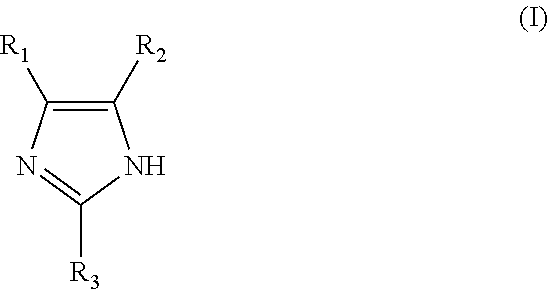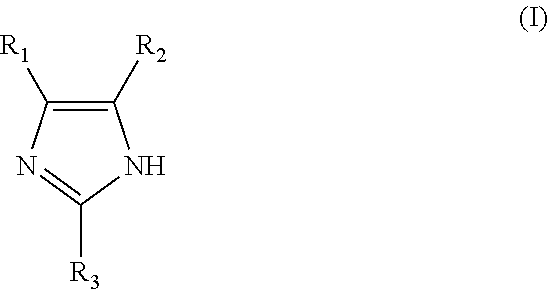Method of filling through-holes
a technology of through-holes and copper plating, which is applied in the direction of liquid/solution decomposition chemical coatings, coatings, printed circuit manufacturing, etc., can solve the problems of copper plating's tendency to fill through-holes, the difficulty of copper plating's high aspect ratio, and the way it tends to fill, so as to reduce or inhibit the formation of dimples and voids, good through-hole filling, and the effect of improving throwing power
- Summary
- Abstract
- Description
- Claims
- Application Information
AI Technical Summary
Benefits of technology
Problems solved by technology
Method used
Image
Examples
example 1
[0033]63 mmol of 1,4-Butanediol diglycidyl ether (monomer 1), 25 mmol of imidazole (monomer 2) and 75 mmol of 4-phenylimidazole (monomer 3) were added at room temperature into a round-bottom reaction flask. Then, 30 ml of DI water was added to the flask. The initially formed white colored suspension eventually disappeared as the reaction temperature increased and turned into a phase separated mixture. The reaction mixture was heated for 2 hours using an oil bath set to 98° C. After adding 2 ml of concentrated sulfuric acid into the reaction flask, the solution became transparent with a light-yellow color. The mixture was heated for an additional 3 hours and left stirring at room temperature for another 8 hours. The resulting amber colored reaction product was transferred into a volumetric flask, rinsed and diluted with 0.5-1% sulfuric acid. The reaction product solution was used without further purification. Analysis of the reaction product by 1H NMR (500 MHz, DMSO-d6) showed the fo...
examples 2
[0035]Two FR4 / glass-epoxy coupons 5 cm wide, 15 cm long and 100 μm thick with a plurality of through-holes were provided by Tech Circuit. The through-holes had an average diameter of 100 μm. The coupons were plated with electroless copper on the surface and in the through-holes. The thickness of the electroless copper layer was 0.3 μm.
[0036]One coupon was placed in a dessicator until further processing to discourage oxidation of the copper and the other was plated with a layer of flash copper by placing the electroless copper coupon in a plating cell which contained an acid copper electroplating bath with a formula as shown in Table 1.
TABLE 1COMPONENTAMOUNTCopper sulfate pentahydrate220g / LSulfuric acid40g / LChloride ion from hydrochloric acid50ppmPolyethylene glycol2g / L4-phenylimidazole / imidazole / 1,4-butandiol50mg / Ldiglycidyl ether copolymerBis-(sodiumsulfopropyl)-disulfide10mg / LWaterTo oneliter
[0037]The coupon was connected to a conventional DC rectifier. The counter electrode was a...
example 3
[0039]Two FR4 / glass-epoxy coupons 5 cm wide, 15 cm long and 100 μm thick with a plurality of through-holes were provided by Tech Circuit. The through-holes had an average diameter of 100 μm. Each coupon included a layer of electroless copper 0.3 μm. One coupon was placed in a dessicator and the other was electroplated with a flash copper layer 5 μm thick as described in Example 2 above. The coupon was then placed in the dessicator with the other coupon until further processing to discourage oxide formation on the copper.
[0040]Upon removing the coupons from the dessicator, both were cleaned using a conventional copper surface cleaner to remove any oxide and provide a clean copper surface for further processing. Each coupon was then placed into two separate plating cells containing the copper electroplating bath of Table 1. The counter electrodes were insoluble anodes. Acid copper electroplating was done at a current density of 1.5 A / dm2 with continuous air agitation of the baths for ...
PUM
| Property | Measurement | Unit |
|---|---|---|
| Fraction | aaaaa | aaaaa |
| Fraction | aaaaa | aaaaa |
| Fraction | aaaaa | aaaaa |
Abstract
Description
Claims
Application Information
 Login to View More
Login to View More - R&D
- Intellectual Property
- Life Sciences
- Materials
- Tech Scout
- Unparalleled Data Quality
- Higher Quality Content
- 60% Fewer Hallucinations
Browse by: Latest US Patents, China's latest patents, Technical Efficacy Thesaurus, Application Domain, Technology Topic, Popular Technical Reports.
© 2025 PatSnap. All rights reserved.Legal|Privacy policy|Modern Slavery Act Transparency Statement|Sitemap|About US| Contact US: help@patsnap.com



